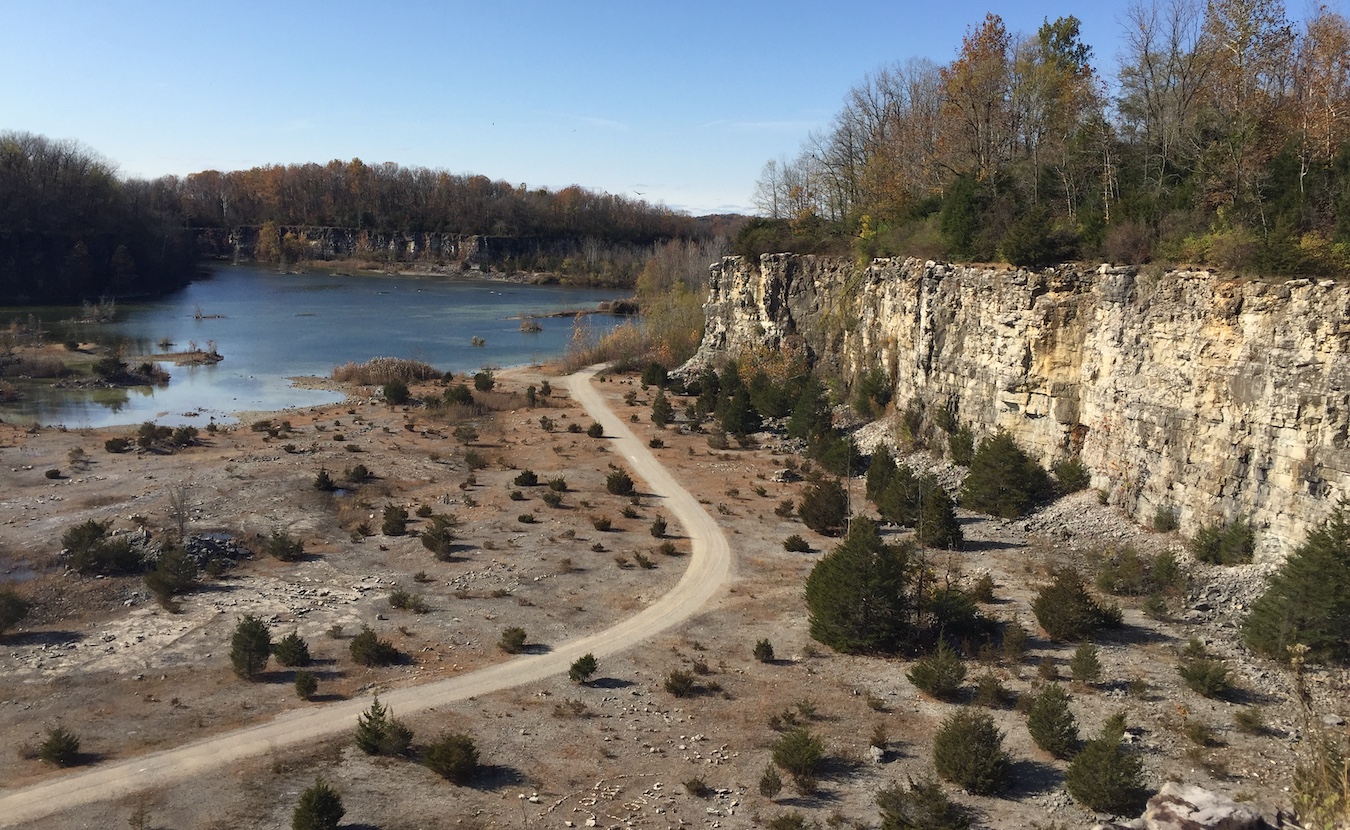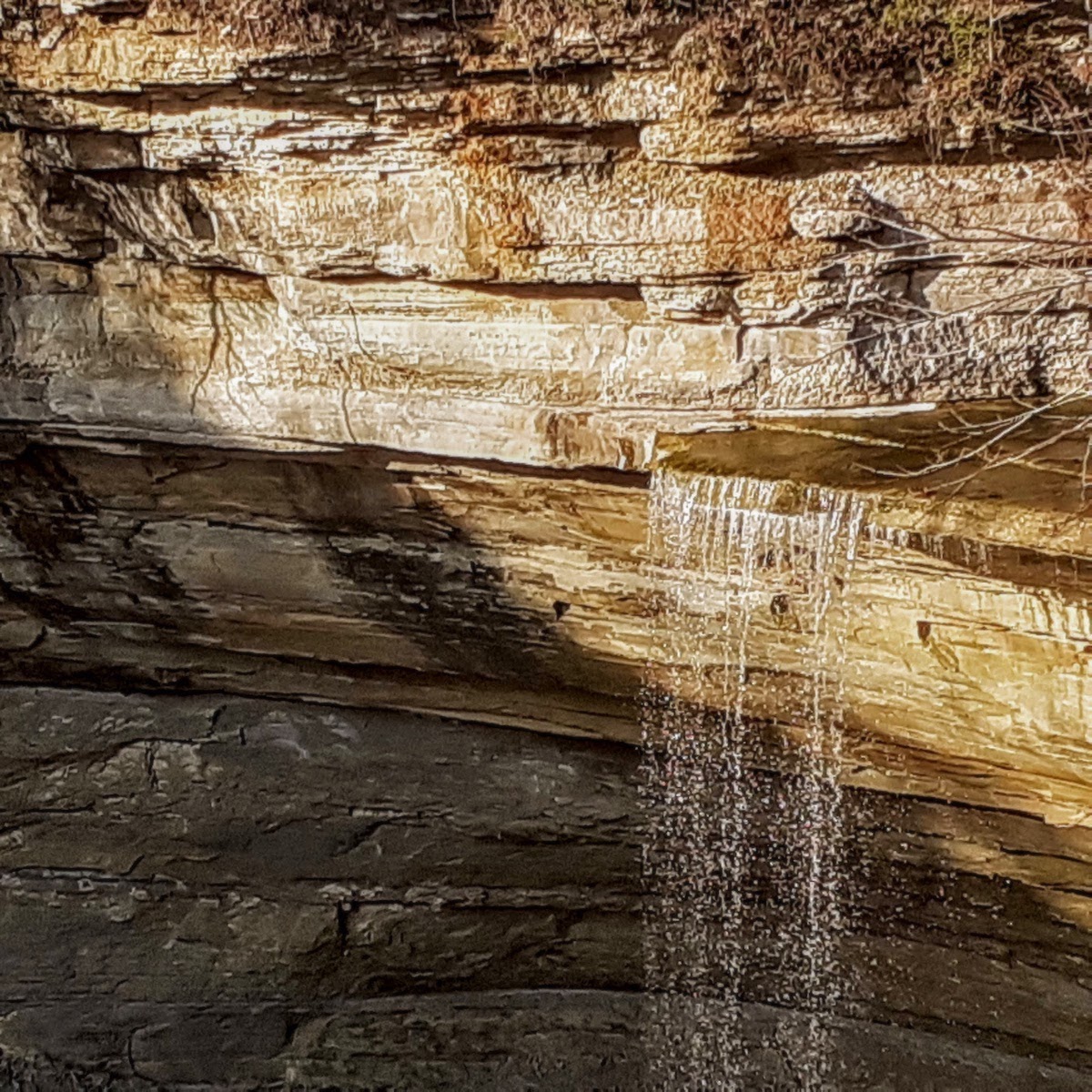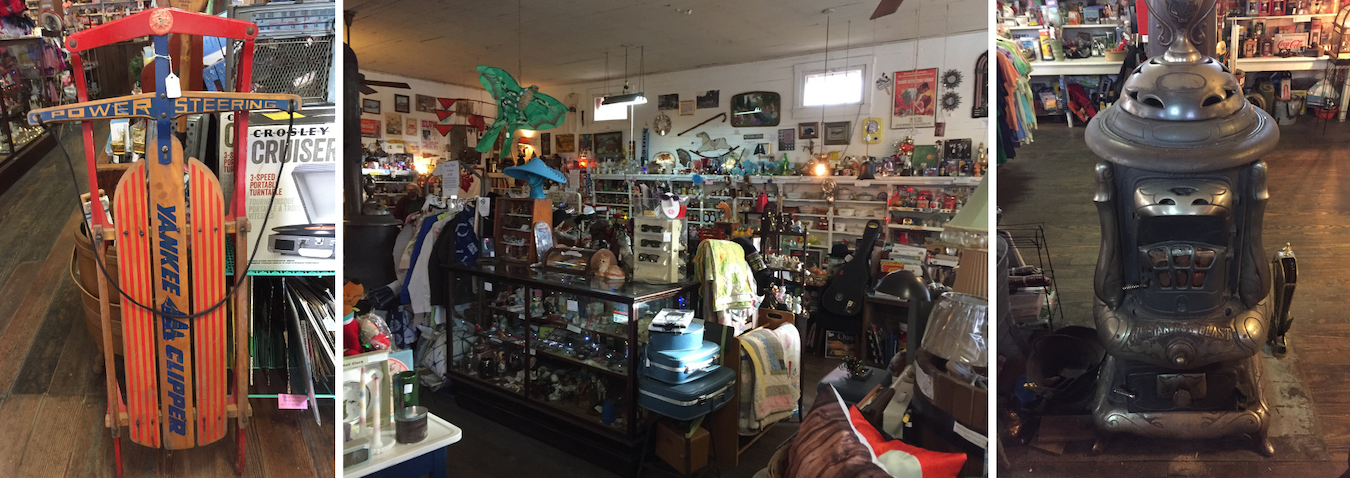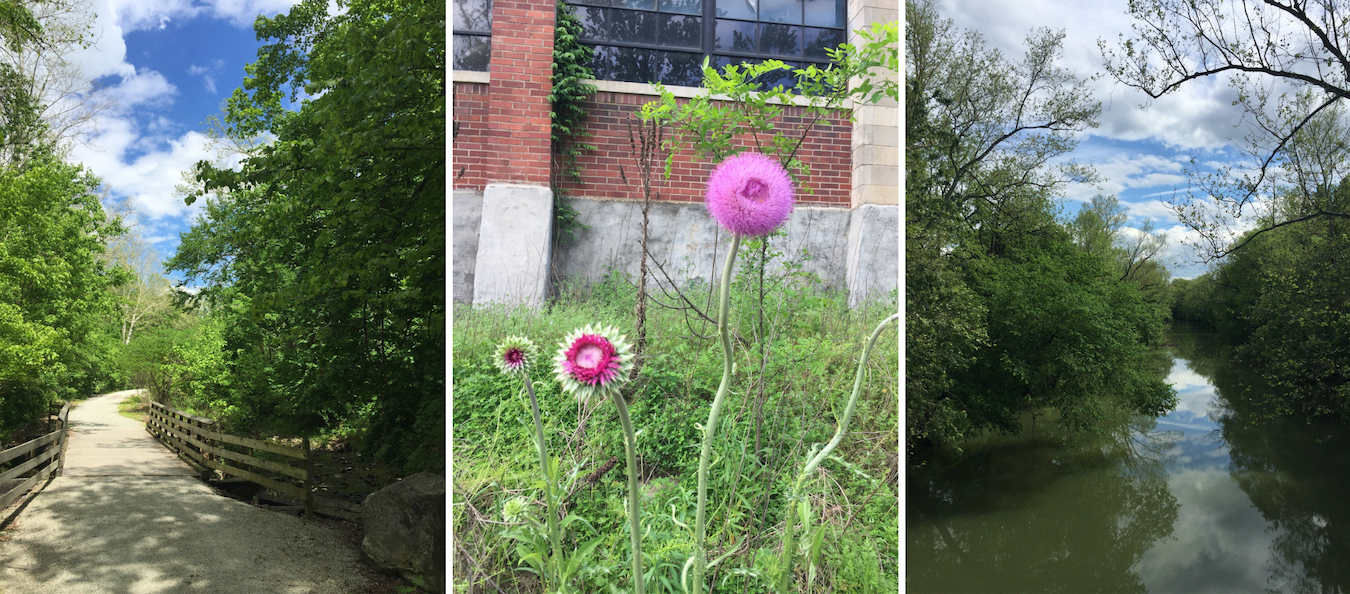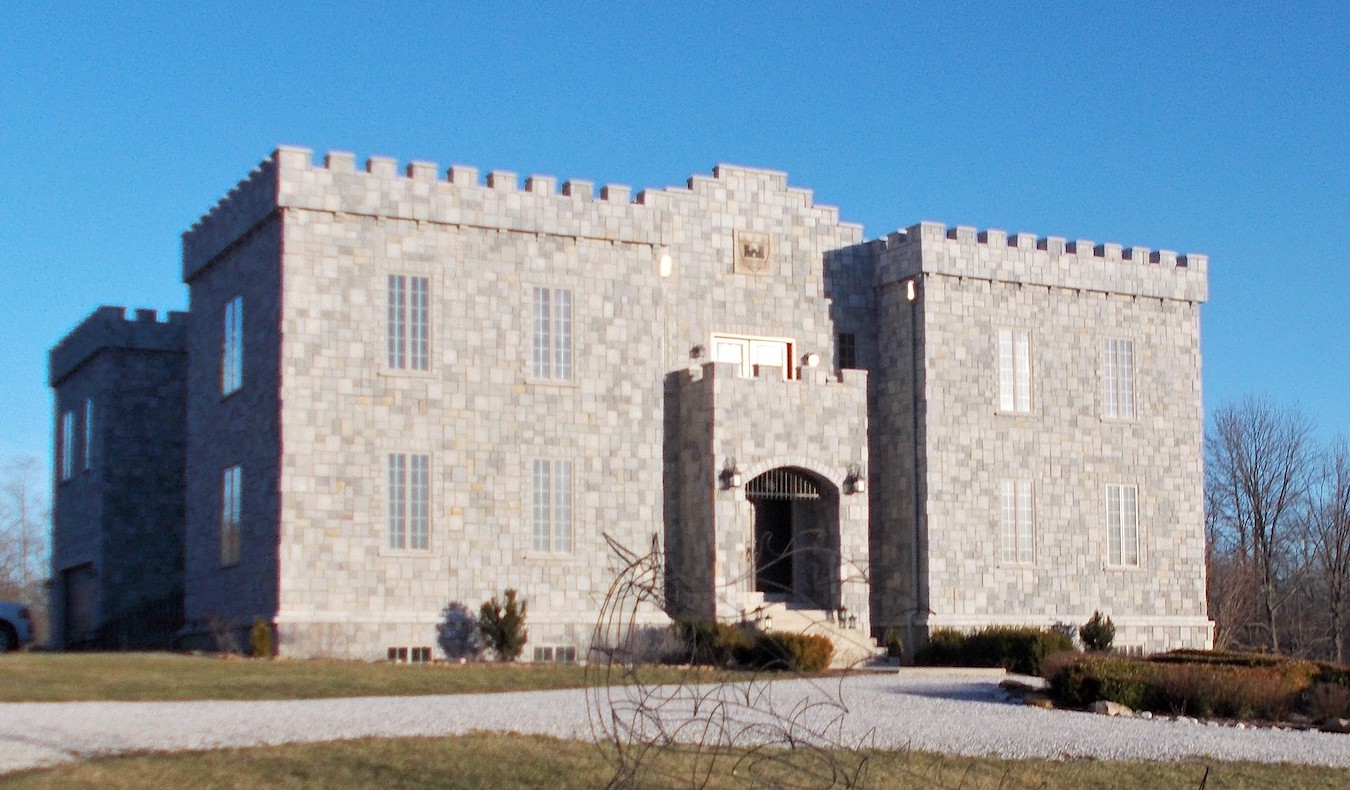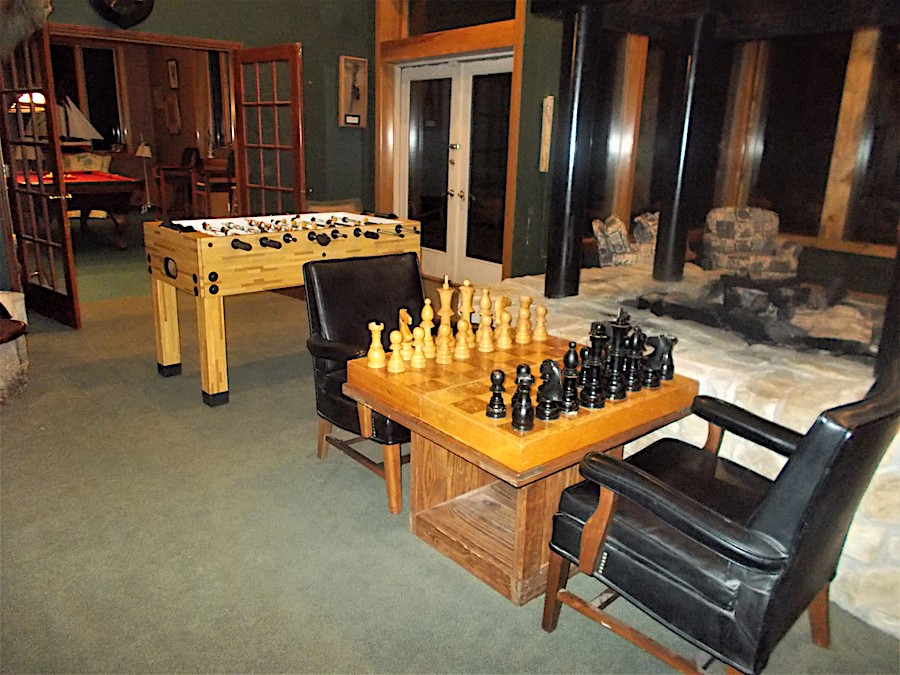I am not one to shout “whoo-hoo!” and shed my mask. I’ve had both vaccinations, but that’s not true of all my friends, and it’s still not clear whether the fully vaccinated can spread the virus.
But we are safer than we were a year ago, and after 14 months of unprecedented isolation and staying put, we can start to think about emerging from our homebound lives. And what better way to do that than with a good road trip? Or several road trips?
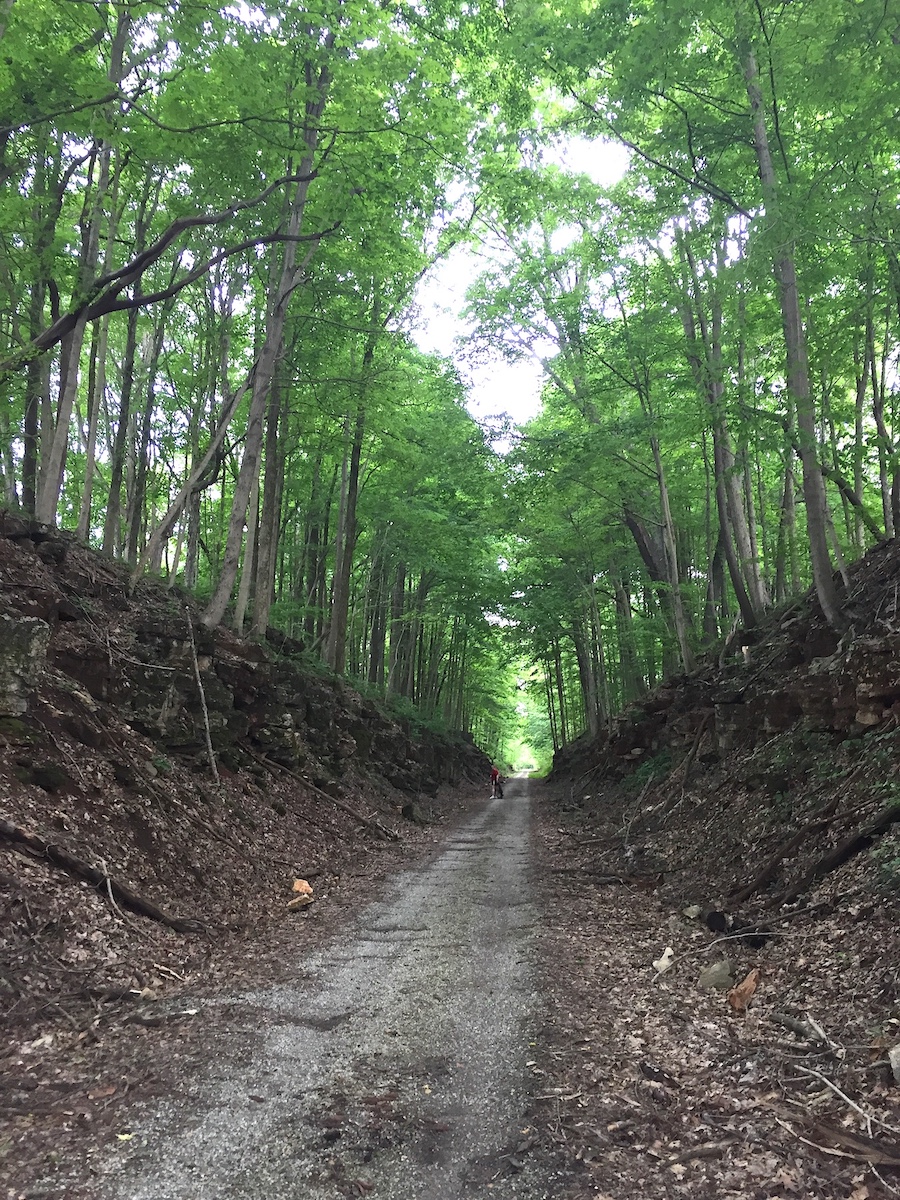
Hitting the trail — as in the Milwaukee Trail in Bedford — will soon have you surrounded by forest and limestone. | Limestone Post
Safety still comes first, and it’s smart to check the Indiana COVID-19 Dashboard to see local county infection rates and be cognizant that not everyone is vaccinated, so wearing masks, washing hands, and observing CDC guidelines is still important. With those considerations in mind, here is a list of fun day trips and excursions specially designed to put an end to the stay-at-home blues.
With the exception of the overnight stays, most of these destinations are cheap or even free. This list is heavy on the outdoor activity; many are staffed by people pursuing their passions. Aside from the state parks, the destinations are owned by local entrepreneurs or nonprofits, so you can feel good about fueling the post-Covid economic recovery. All are within a two-hour drive from Bloomington.
Chasing Waterfalls
Water falling over rocks is magic; few things are more cathartic and mesmerizing than the uproarious wash and rush of water. Right after spring rains is the best time to visit, when the water roars, mossy rocks are greenest, and wildflowers are at their most luxuriant.
This list of scenic falls in southern Indiana isn’t exhaustive, but because too much of a good thing can be wonderful, you can see several on each of these three day trips, divided by region. Keep in mind that waterfall access can be dangerous, with steep heights, slippery mud, and stony paths. It’s best to take a friend and prevent accidents by wearing tough shoes with good traction.
East by Southeast
Anderson Falls is a former Nature Conservancy site a few miles east of Columbus, now owned and managed by the Bartholomew County Parks Department. It’s got a definite swimming-hole vibe; every time I’ve gone, people have been playing in the water, even when there’s snow on the ground, and even though it’s not altogether clear whether it’s permissible. The downside to its accessibility is some graffiti on the rocks and the odd beer can, but the flowers and the beautiful shoals along this creek make it worth the quest.
From Anderson Falls, go about 20 miles south to Jennings County for three waterfalls within a few miles of each other. First check out Muscatatuck Park, just south of North Vernon on South Gum Street. Once the smallest state park in Indiana, the park is now run by Jennings County. With a smaller piggybank for maintenance, the trails “are what they are on any given day,” according to the staff person I talked to in the park’s office. The day I was there, I couldn’t reach Muscatatuck Falls on the River Trail. Since I’d foolishly not worn hiking boots, I found myself sliding sideways and down on the eroded trail and annoying a lot of turtles, if the constant plops in the river were any way to judge. I gave up and contented myself with the woodland trails.
The small spring-fed fall behind Vinegar Mill is much easier to reach. It squirts out between two crevices in moss-covered limestone walls directly behind the mill site. As the name Vinegar Mill suggests, the park was once the site of a stone mill, although the origin of the name “Vinegar” is in dispute. The main purpose of the property was once quarrying, and the 1850 house of the quarry’s original owner, William Read, serves as the park’s office. Check out the Read House exhibit on Morgan’s Raid, a Confederate cavalry campaign that terrorized parts of Jennings County during the Civil War.
From Muscatatuck Park, head a few miles northeast to the tiny gem that is Calli Nature Preserve, which is owned by the Jennings County Community Foundation (click here for directions). Take the long loop trail which leads to the river, and you’ll see hillsides covered with wildflowers and big trees chewed by ambitious beavers. (I couldn’t find the beaver dam, but maybe you can!) The waterfall there, Rock Rest Falls, is best approached from the road by car.
You can fuel your trip by stopping in North Vernon at Bohemian Donuts (coffee plus a heady assortment of doughnuts) or Brick Street (all-day breakfast and stick-to-your-ribs food served up by a mother-and-daughter team).
Clifty Falls
Clifty Falls State Park has four falls efficiently packed into one beautiful destination. All of the falls are among the highest in Indiana, hence the “clifty.” It’s possible to do a loop trail with all four falls: Hoffman, Tunnel, Little Clifty, and Big Clifty. If you try this, check with a park ranger for advice because it will involve mixing and matching trails on the map. If you don’t want to be a hero, you can also just drive close to all of the falls.
Save some energy for Madison, arguably the prettiest town in Indiana. In 2006, more than 130 blocks of Madison’s downtown area were designated as the largest contiguous National Historic Landmark in the United States. Madison was laid out and platted in 1810, and many of the buildings still existing today are pre–Civil War, when Madison was in its heyday. Every major architectural style of the 19th century is represented in Madison; even the gas stations are beautiful, with one near the Ohio River boasting a dentil front, a common feature in Greek and Roman architecture.
Madison has a multitude of shops and restaurants. The Tap Off Broadway has good food and beer; Red Roaster is larger and more local than Starbucks, as well as more delicious; and The Downtowner has the best cake anywhere.
After eating, stroll down the brick walkway along the river, enjoy the trees, and watch barges floating by. Or you can walk to Kentucky across the historic Milton-Madison Bridge, which has a five-foot pedestrian sidewalk along its two-lane roadbed.
Owen County represent!
The heart of McCormick’s Creek State Park is its limestone canyon and waterfall — at its most torrential in spring. The waterfall hike is a rugged .8 miles at Trail 3, beginning near the Canyon Inn. You can view the falls from above or take a swinging bridge down to the floor of the canyon, where people piddle about in the water, balancing on the rocks in the creek or building cairns.
But the biggest and best of the falls in Owen County is also the largest waterfall by volume in Indiana. The Upper Falls in the Cataract Falls State Recreation Area plummets 20 feet in a deafening roar. There’s no question of whether playing in the water is permissible here, as the water is much too swift and people have drowned in the creek, but you can take lunch and eat on one of the picnic tables inside the restored 1876 covered bridge just south of the falls.

The largest waterfall by volume in Indiana is Upper Falls in the Cataract Falls State Recreation Area (above) in Owen County. But Walker says not hiking a mile north along Mill Creek to Lower Falls would be a mistake, ‘because it’s a beautiful falls in its own right.’ | Limestone Post
A pleasant hike about a mile north will take you to the Lower Falls of Mill Creek. The creek spreads wider here, and the Lower Falls aren’t as tall as the Upper Falls or as dramatic. Because of this, they’re often skipped by visitors to Cataract Falls; this is a mistake, because it’s a beautiful falls in its own right.

The Cataract General Store is another ‘Owen County contender for statewide distinction.’ | Photo by Diane Walker
After Cataract Falls, head to another Owen County contender for statewide distinction, the Cataract General Store, one of the oldest general stores in the state — pot-belly stove, pickle barrel, and all. Established in 1860, the store has food, specialty soda, and a variety of other weird, funny, one-of-a-kind items. Cathie Kuntz, who runs the store with her husband, Scott, says she’s “like a crow — I see something shiny and I have to stop and look at it.” A lot of these shiny items have wound up in the store, as have collectibles Cathie inherited from her aunts and mother.
Jars of homemade salsa are cheek by jowl with a 1960s portable record player; a vintage, round overnight case; and new items like fuzzy black house shoes embroidered with the AC/DC band logo or Crazy Cat Lady stickers (“With Hairballs!”).
One of the best parts of the store are the signs and stickers penned by Cathie, stuck on merchandise and random places. A sign on the store’s door explains how the mechanism works, invoking Salt-N-Pepa: “Hold the latch down and push. Push it real good.” The blackboard above shelves of merchandise has a timeline of events in the history of the nation and the town. “1876: American Centennial, Cataract Covered Bridge Built. Custer picks his last fight, Wild Bill plays his last hand.”
Among other things, I bought a DVD of the movie Bluebeard … The Most Sinister Love Story Ever Told!, partly because the price sticker said, “Almost a chick flick! $3.00.” It’s all a vast amount of fun, and you’re guaranteed to find something you didn’t know you wanted but have an urgent and illogical desire to possess.
More Road Trips of Distinction
Missing Middle-earth? Or the American Southwest?
About 50 miles northwest of Bloomington, in Putnam County, two sites that do not look like typical Hoosier countryside might assuage your wanderlust until flying feels completely safe.
The first of these, Fern Cliff Nature Preserve, is a Nature Conservancy site with an unexpected sandstone canyon in the middle of farmland. The preserve is verdant with ferns and bryophites, rugged moss-covered boulders, and gnarled tree roots. If you had to, you could hide from the Black Rider, like Frodo and the boys in Lord of the Rings: Fellowship of the Ring.

Fern Cliff Nature Preserve and DePauw Nature Park are only 7 miles apart, but neither is typical of the surrounding Putnam County countryside. Walker says Fern Cliff (left) is more like Middle-earth, while DePauw Nature Park (right) might evoke the Arizona desert. | Limestone Post
The trail at Fern Cliff is only 1.5 miles, so afterward travel the 7 miles to DePauw Nature Park, a 520-acre abandoned limestone quarry with a strange resemblance to the Arizona desert — or at least as close as you’ll find in Indiana. The quarry looks like a canyon, with sycamore trees and scrubby junipers reclaiming the rock floor. A shallow lake completes the illusion of a desert oasis. The park has 9.6 miles of hiking and some really friendly deer — not to mention a volt of vultures that look cast from a movie Western.
Afterward, drive east to nearby Greencastle, where the courthouse square has outdone itself with military yard ornaments. In the U.S., there are only two unexploded buzz bombs, Hitler’s early, jet-propelled V-1 cruise missiles. One of them is on the southwest side of Greencastle’s town square. Soon after World War II, a local Navy reservist, Frank Durham, persuaded his senator to pass a bill preventing the buzz bomb from being destroyed with other enemy ordnance. He then arranged to transport it home to honor Putnam County’s soldiers killed in WWII, and the missile was dedicated as a memorial on Armistice Day in 1947.
Across the street is an Old National Bank that was the site of John Dillinger’s largest haul. In October 1933, less than two weeks after Dillinger had busted out of a jail in Ohio, his gang hit what was then the Central Bank. Without firing a shot, they got away with about $75,000, almost $1.5 million in today’s dollars.

On Washington Street in Greencastle, Conspire: Contemporary Craft is a teen community center as well as a store that works with 130 local and regional craftspeople to sell handmade products. | Photo by Diane Walker
While you’re admiring the Americana, walk east on Washington Street to check out an innovative store called Conspire: Contemporary Craft. A sign outside proclaims, “We don’t all fit in this world. That’s why we’re making a new one.” The store works with 130 local and regional craftspeople to sell handmade products, including furniture, housewares, prints, clothing, and accessories. The store’s owner, J.D. Grove, makes Granola Girl skincare products onsite while customers watch.
Conspire is also a community center where local teens can make art and hang out. A section at the back has free clothing and food for the taking by people in need. Beginning in June, the store will offer lessons in embroidery, jewelry making, yoga, and meditation.
Greencastle is a small, walkable college town (home of Depauw University) that also has some great food. Breadworks is light and airy and sells sourdough bread loaves as big as your head for $2.50. Dairy Castle sells soft-serve ice cream almost the same size. Wasser, a brewery and restaurant northeast of the square, has great food. My friend loved the fish tacos so much I thought he was going to start rolling around on the floor in ecstasy.
Riding the Rail Trail
South of Bloomington, Tenth and Lincoln streets in Bedford is the beginning of the 10.9-mile Milwaukee Trail. The first 1.5 miles is no great shakes scenically, but soon you’ll be surrounded by limestone and forest, and after mile 4 you’ll ride alongside the East Fork of the White River — with abundant deer, squirrels, birds, and moss-covered quarried blocks of limestone. If you look closely among the trees lining the trail, you’ll see tabletop rock formations, with slabs of rock perched miraculously on pointed limestone columns.
The trail is easy, but that shouldn’t stop you from carbo-loading at Magic Morning, located on US 50 as you head east into town from State Road 37. This mom-and-pop bakery makes superlative cinnamon rolls; unfortunately, it’s closed on Sundays. For different kind of carbs, check out Salt Creek Brewery’s excellent IPAs, just north of Bedford in Needmore.
Lyles Station
When he was 17 years old, Stanley Madison rescued a horse-drawn plow from a building before it was demolished in his hometown of Lyles Station, a community founded in 1849 by free African American pioneers in Gibson County. Stanley carried the plow on his back for the two-and-a-half-mile walk home because it was important to him that it be preserved. In 2016, almost 50 years later, he sent that same plow to be part of Lyles Station’s exhibit, “The Power of Place,” in the Smithsonian Institution’s National Museum of African American History and Culture in Washington, DC. The Lyles Station exhibit at the museum demonstrates Black farmers’ commitment to and investment in their land.
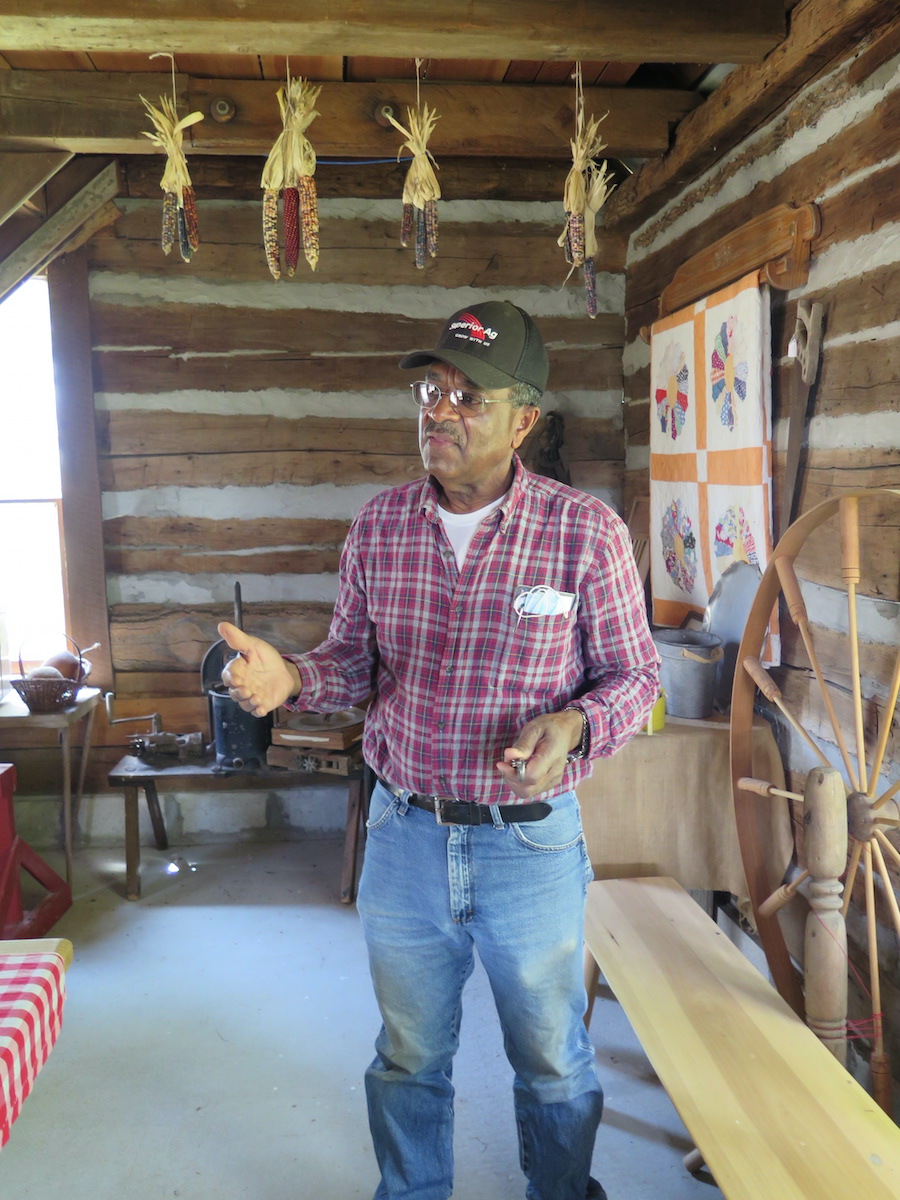
Stanley Madison still raises cattle and grows crops near his ancestors’ community of Lyles Station in Gibson County, but his principal vocation is founder and president of the nonprofit Lyles Station Historic Preservation Corporation. | Limestone Post
Stanley’s great-grandfather settled in Gibson County in about 1838, but the first free Black people settled there in 1814. Now in his 70s and retired from the local power plant, Stanley still raises cattle and grows crops near his ancestors’ community, but his principal vocation is founder and president of the nonprofit Lyles Station Historic Preservation Corporation.
The Lyles Station Consolidated School is home to a museum telling the story of the community, which was a stop on the Underground Railroad. After the Civil War and through the late 19th century, the town grew to about 800 people. During the Great Flood of 1913, the Patoka and Wabash rivers flooded the community, destroying farms and homes. Residents began to leave for better jobs and economic opportunities, and today only about 15 families remain, some of whom are among the 45,000 Black farmers in the U.S., or about 1.3 percent of the 3.4 million U.S. farmers.
The Lyles Station museum is a labor of love for Stanley and local residents, with hundreds of pioneer artifacts, including a saddle used by Stanley’s uncle, McKinley Madison, as a World War I cavalry soldier. The museum contains a re-created schoolroom from the early 1900s, where today’s Indiana schoolchildren visit for the day and follow a lesson plan similar to that of former students, including a daily spelling test of 16 vocabulary words. School kids also have the chance to play 19th century games, churn butter, make candles, and wash clothes on a washboard.
In addition to the school, the museum property includes the Wayman Chapel AME Church, which still holds services, and a log cabin similar to those built by pioneers. A period garden will be supplemented by a greenhouse shortly, and on September 11, 2021, the museum will hold a farm-to-table celebration. The Juneteenth Celebration, celebrating the end of slavery in the United States, will be held this year on June 19 from 11 a.m. to 3 p.m.
Stanley’s plans for the museum include reconstruction of some of the town buildings, an amphitheater for music, and a restaurant. For now, Stanley also gives tours of the museum — Tuesday through Saturday from 1 to 4 p.m. CST (like much of southwest Indiana, Lyles Station observes Central Time) — lingering as long as people want to talk or ask questions about Lyles Station, a subject for which he has unending passion, knowledge, and commitment.
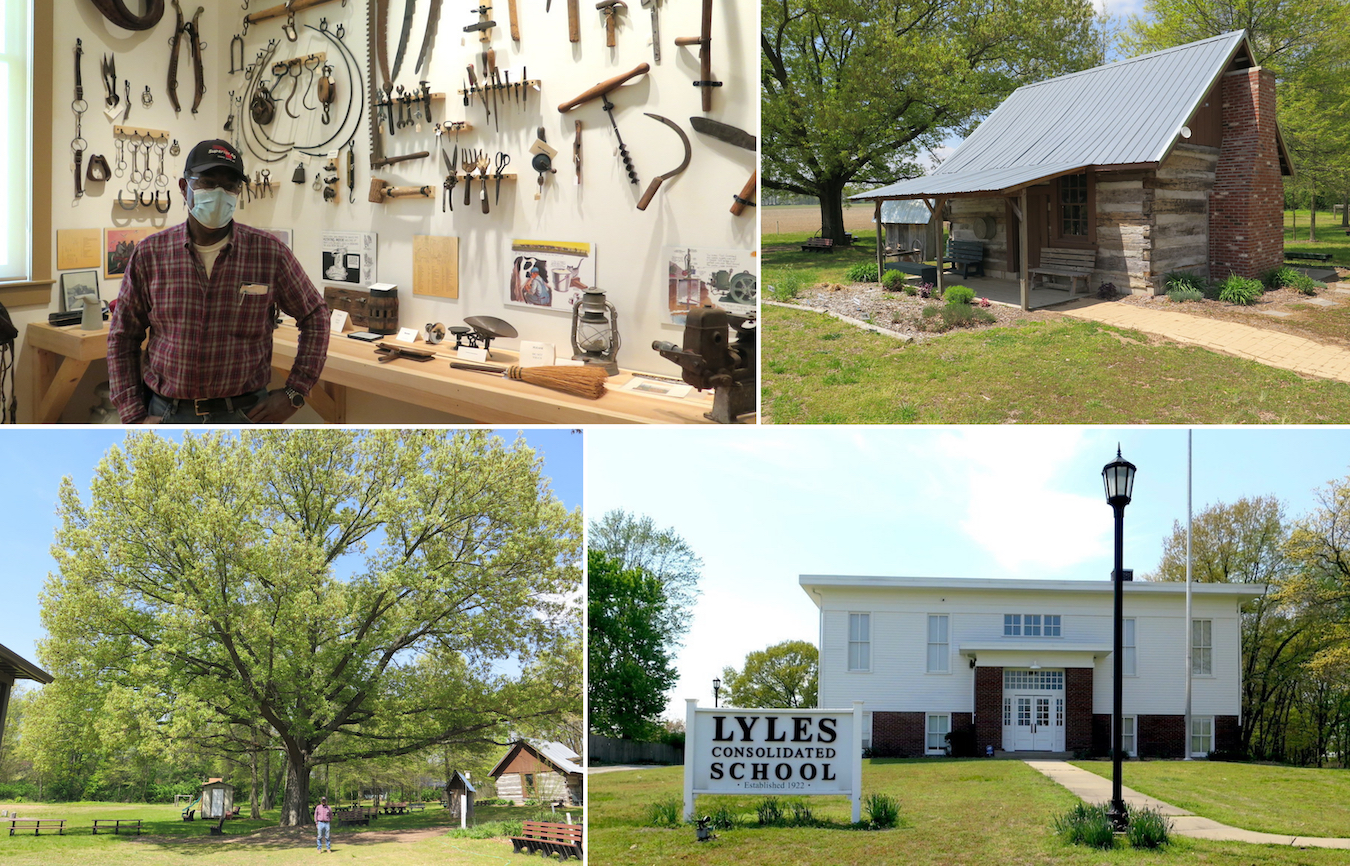
(top left) Stanley Madison in the Lyles Station museum, which holds hundreds of pioneer artifacts; similar items from Lyles Station are featured in the exhibit ‘The Power of Place’ in the Smithsonian Institution’s National Museum of African American History and Culture in Washington, DC. (top right) This log cabin, similar to those built by early pioneers, is where today’s schoolchildren learn about pioneer life at Lyles Station. (bottom left) Stanley stands under an oak tree at Lyles Station, which used to be a stopover on the Underground Railroad, and on June 19 will hold a Juneteenth Celebration. (bottom right) The museum is in the Lyles Station Consolidated School, which also houses a re-created schoolroom from the early 1900s. | Limestone Post
A Hoosier refuge, for a time
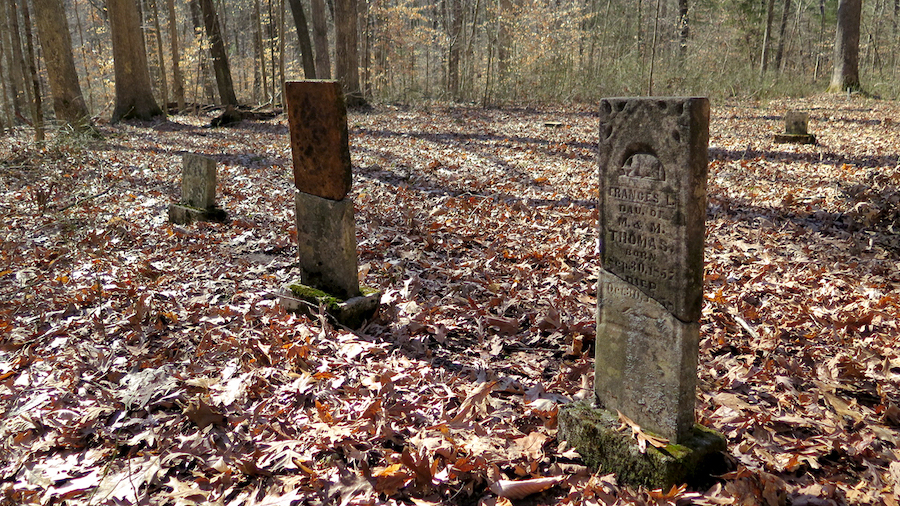
A cemetery is the only visible remnant of the Lick Creek settlement in Orange County, which during the 1800s was one of the largest settlements in Indiana for free people of color. | Limestone Post
A hike can be more than communing with nature; it can be a chance to learn forgotten history. Two hundred years ago, free African Americans fled racial discrimination in North Carolina, Virginia, and Tennessee to settle in southern Indiana on land now covered by the Hoosier National Forest, a few miles southeast of Paoli in Orange County. By 1836, the settlement, known as Lick Creek, was one of the largest settlements in Indiana for free people of color and a likely stopover on the Underground Railroad. However, after the Civil War began and racism increased in the area, seven Lick Creek families emigrated to Canada, an exodus which began the decline of the settlement. But Mathew Thomas, who had bought the first parcel of land in what would become Lick Creek, had no intention of leaving.
The only visible remnant of the Lick Creek settlement today is the cemetery on land formerly owned by Thomas and a fellow Black pioneer, Ishmael Roberts; it’s the burial site of many of the Lick Creek settlers. The cemetery includes the grave of Simon Locust, a Lick Creek farmer who joined the United States Colored Troops at the age of 40. Although enough headstones remain to remind us of the pioneers who braved racism and the hardships of frontier life, many of the graves are unmarked, the residents too poor to buy stone markers. The Lick Creek trail itself is a 7.7-mile loop from the designated parking area off of County Road 450 South. About halfway along the trail, a sign points to the Thomas-Roberts Cemetery.
The cemetery is remote, but it’s a beautiful hike through hardwood forests, with the opportunity to commune with courageous souls from a fascinating, almost forgotten history.
[Editor’s note: Read Diane Walker’s article on the history of Lick Creek here.]
Meanwhile, back at the castle …
The Middle Ages were deadly serious, with wars, plagues, and inquisitions, but Clayshire Castle in Bowling Green, Indiana, three miles north of State Road 46, is as playful as Monty Python’s knights hunting a grail. The bed and breakfast is an idyllic limestone castle on 120 acres of Clay County forest, with a dragon made of Christmas lights, a troll under a bridge, and a giant chess set on the lawn, with pieces as big as a small child.
Despite its tongue-in-cheek approach, the castle is serious about luxury, with gourmet breakfasts and sumptuously furnished rooms. When I stayed, I meant to check out the lute and re-created 14th-century clavichord, or stargaze with the telescope that allows guests to look at some of the least light-polluted skies in Indiana. I meant to borrow one of the period costumes available for free to guests, and curl up in front of my room’s fireplace with a DVD from the dozens of historically themed movies in Clayshire’s collection. Instead, I got distracted by hiking and making a giant bonfire with my friends. Hotel rooms can be reserved for $200 a night on weekdays, $225 a night on weekends, and it’s all a magnificent getaway from the 21st century.
Waking from its nap
Spencer used to be a somnolent town where the parking meters took pennies, and it didn’t matter if you fed the meter because no one ever seemed to check them. But Spencer is coming out of its trance, and its renaissance is a passion project for many residents and local entrepreneurs. New businesses include a cozy coffeehouse, a candy store, and shops offering carefully curated wares, all of which make Spencer’s spirit of pride feel truly special. Literally. Spencer Pride’s CommUnity Center is in a beautifully restored building and has a joyous vibe of welcome and acceptance, along with funky merchandise, sales of which support the center.
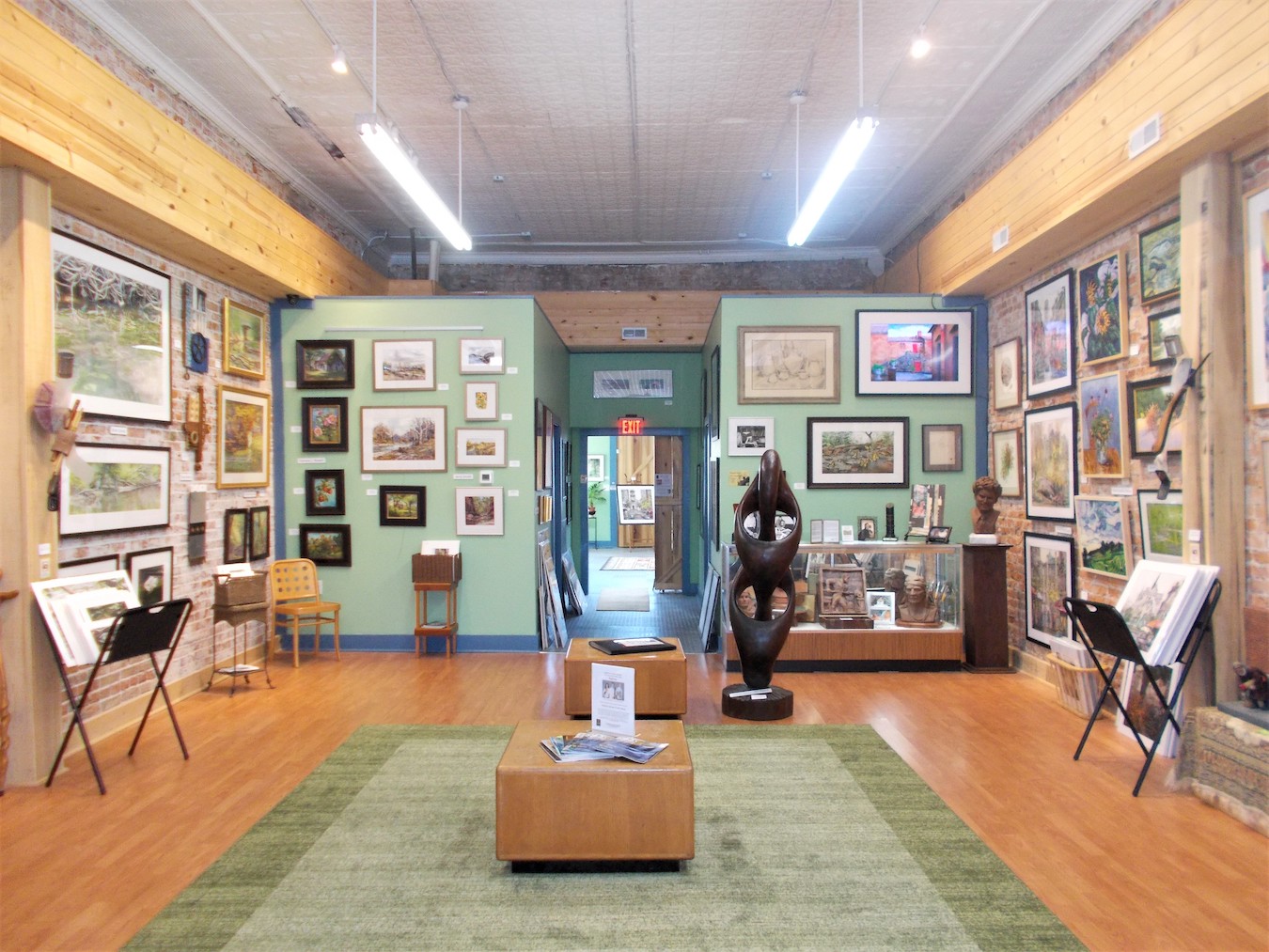
Juniper Art Gallery is just one of the reasons you could make a day of it in Spencer. | Photo by Diane Walker
Main Street Coffee and Kitchen makes some of the best sandwiches I’ve ever had. Jit’s Thai Bistro offers authentic Thai food in a beautiful little restaurant, which is also a nice place to have a glass of wine or beer on a weekend night. The menu takes no prisoners. It lets you know that if you try the “Thai Hot” level of seasoning on your order and can’t hack it, you won’t get your money back.
Juniper Art Gallery and The Dragonfly Gallery have a diverting selection of witty gifts, along with lovely paintings and sculpture. The owner is artist Jaime Sweany, the onetime proprietor of Wandering Turtle Gallery and Gifts in Bloomington. As for the 1920s Tivoli Theatre, yes, the building is beautiful, and $5 first-run movies are awesome, but what is most endearing about this movie house is that instead of a bossy PSA telling you to turn off your phone, a Tivoli volunteer goes on stage and reminds you nicely to be considerate during the movie. The audience claps for the volunteer and usually claps when the movie is done. The theater is observing social distancing in seating and masking for the foreseeable future. Next door to the Tivoli, you can finish your day of small-town warmth and welcome with poutine and deliciously hoppy beer at Civilian Brewing Corps.
All of this is happening in a town with a population of 2,200. Spencer Pride claims to have the largest pride festival for a town its size in the Midwest, which will be held this year on October 16. But you can venture beyond the Spencer city limits: The tagline for Owen County Visitors Center, “Sweet Owen,” suggests other attractions: Our Lil’ Bit of Heaven Animal Rescue and Sanctuary, Owen Valley Winery, the aforementioned McCormick’s Creek State Park, the lesser-known hardwood forests and sandstone bluffs of Owen-Putnam State Forest, and Wasatch Lake …
Hygge
The Danish word for the essence of coziness is pronounced h(y)oogǝ. In Poland (Indiana), you might just say “Wasatch Lake.” The rustic cabins at Wasatch Lake retreat, a few miles west of Cataract Falls, are fully furnished, except for internet. That means nothing will distract you from watching bald eagles fly across the lake, kayaking with the complementary boats, or gathering with friends around the outdoor fire pits. Along miles of hiking trails, kids will enjoy the Faces of Wasatch Challenge, a hunt for the Mr. Potato–head-like sculptures affixed to trees. They give prizes for finding them! No prizes are given, however, for winning the affection of the onsite duo of pot-bellied pigs; they will be your friend for food or friendly pats.
All guests have access to the 1940s-era rustic lodge at Wasatch, which has billiards, Ping-Pong, foosball, and an oversized chess table. To say the staff at Wasatch is accommodating is an understatement. I dropped my car’s electronic key fob in the lake, destroying it, and the anti-theft system wouldn’t let me start my car. One of the caretakers worked on my car for more than an hour, unwiring and rewiring the electric system so I could drive it. Your needs will hopefully be different, but graciously met. Cabins sleep four to eight people, with rates depending on the day of the week and number of beds.
Peninsula of Broken Dreams
A hundred years ago, thousands traveled to chase their dreams at Rose Island: luxuriating at the hotel and glamp cabins, riding the coaster and Ferris Wheel, or ogling wolves, monkeys, and a black bear named Teddy Roosevelt. In the good-time daze of the 1920s, fifty cents (now about $6.62) bought a steamboat ticket from Madison to Rose Island, or holiday makers crossed the 50-foot-long swinging wooden bridge over Fourteen Mile Creek, guaranteed to make sweethearts scream if you were jerk enough to sway it.
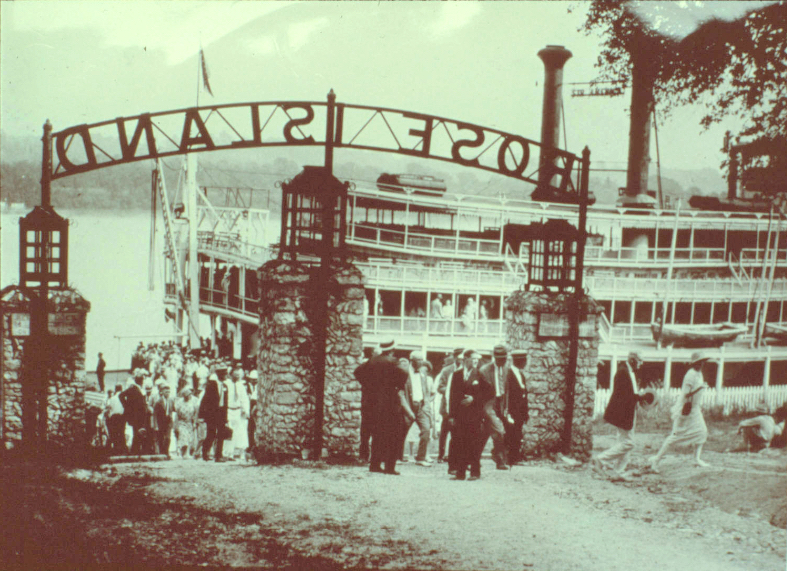
Rose Island historical photo from the Jeffersonville Public Library/Clark County Visual History; the caption reads: ‘The steamer, “America,” is shown embarking passengers at the entrance to Rose Island around 1925. Notice how well dressed everyone is. The park was used by many church, school and club groups which made the gatherings a social event and not just a day in the park.’
Rose Island, actually a peninsula, had attracted Victorian picnickers and church campers for years, but in 1923, an entrepreneur named David Rose rebuilt the three-story hotel and included everything he could imagine that might give people pleasure: the first water-filtered swimming pool in the Midwest; a dance hall that accommodated 800 (with a floor that could be laid down for roller skating); outdoor dining, which could also serve 800 customers; golf; and boats to row on the creek.
In 1937, the Ohio River flooded, and water on the island rose 10 feet, and that was the end to Rose Island as a party spot. Rose Island is now part of the Charlestown State Park in Clark County, and is accessed by a walk down a steep hill and across the Portersville Bridge, a 1912 iron bridge relocated from, well, Portersville, Indiana.
The area is dotted with exhibits showing black-and-white pictures of merrymakers and explaining the few ruins of the park that remain. If you can get past how much some of these pictures resemble the photo of Jack Nicholson in the 1921 Overlook Bar at the end of The Shining, it’s fun to imagine all the excitement from 100 years ago. What might people have made, for instance, of the splendiferous tackiness of alligators swimming in the center fountain? Did David Rose’s rule of no alcohol in the park go unbroken? (I’m guessing not.)
Speaking of drinks, make sure you take water to drink on the hike back to your car. The steep, 70-feet hill to the parking lot is mean on the way back up.
Safe travels
All of us need a break and some fun, maybe more now than we ever will again in our lifetimes. Until we can hug every last person we want to hug, attend a concert, a ballgame, do whatever raucous and crowded thing we’ve missed, we can nourish our mental and physical health. Hopefully, and with care, those of us who have come through it safely will continue to do so.
The bright side of the last 14 months — if there is a bright side — is that we might appreciate nature, moving about, learning, and exercising our curiosity about places more than before. Safe travels to everyone, and may you find good health, renewed hope, and lasting pleasure in the coming months!

